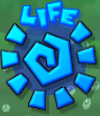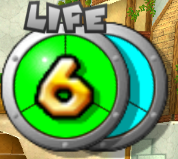Health Meter: Difference between revisions
(→Super Mario Sunshine: I own the game; I know...) |
(→Super Mario Sunshine: Ditto the last edit summary) |
||
| Line 29: | Line 29: | ||
When the Health Meter has lost five sections of energy, an alarm will start to sound for the remaining three sections of health. As each section after this is gradually lost, the alarm will sound faster, and the energy sections will flash to match its warning. As it gets gradually lower, Mario will start to droop lower and lower, visibly getting weaker from the lack of energy. When it has been completely depleted, Mario will lose a life, or if he has no more to lose, will receive a [[Game Over]]. It will automatically be fully depleted if Mario falls in [[lava]], fails a timed Red Coin challenge, or loses a race to [[Il Piantissimo]]. | When the Health Meter has lost five sections of energy, an alarm will start to sound for the remaining three sections of health. As each section after this is gradually lost, the alarm will sound faster, and the energy sections will flash to match its warning. As it gets gradually lower, Mario will start to droop lower and lower, visibly getting weaker from the lack of energy. When it has been completely depleted, Mario will lose a life, or if he has no more to lose, will receive a [[Game Over]]. It will automatically be fully depleted if Mario falls in [[lava]], fails a timed Red Coin challenge, or loses a race to [[Il Piantissimo]]. | ||
Unlike ''[[Super Mario 64]]'', there is a separate meter for Mario's air meter when he is underwater, the only difference being that the entire meter is blue when he swims underwater and that the health sections will gradually begin to deplete when he swims underwater. When the meter depletes to three sections, an alarm will sound as it gets steadily lower, and will continue to do so until Mario collects a coin or returns to the surface. | |||
<br=clear all> | <br=clear all> | ||
Revision as of 23:28, December 17, 2010
In the Mario series, the Health Meter is an on-screen indicator of how much health Mario (or another character) currently has left. It usually appears somewhere on the top of the screen, but can also appear in other locations on the screen as well.
History
Super Mario 64
In Super Mario 64, Mario’s Health Meter is normally not displayed on the screen until he takes considerable damage from falling or touching enemies, etc. When it does appear, it is displayed on the top middle of the screen. In this game, it is shaped like Mario’s head, with a circle in the middle which displays 8 health sections. When he takes damage, some of the sections will gradually disappear.
The color of the health sections corresponds to the number of health sections that remain after he has taken damage: eight to seven are blue, six to five are green, four to three are yellow, and two to one are red. Mario can refill his Health Meter by collecting various coins: Yellow Coins will replenish one section, Red Coins will replenish two sections, and Blue Coins will replenish five sections. He can also refill it by running through Spinning Hearts, which can be found in most if not all of the levels. The faster he runs through them, the more health he will regain.
When the Health Meter reaches two sections, Mario will begin to pant when standing still, though he can still perform moves. If the Health Meter runs out at any time, Mario will lose a life and forcibly exit whatever level he is currently in (excluding Peach’s Castle). It will automatically go to zero if he is crushed by a Whomp or Thwomp. When he no longer has any lives left, he will be given a Game Over.
In this game, Mario's Health Meter also acts as his breath meter when he dives underwater. After diving underwater, the health sections will gradually deplete. When only two sections remain, an alarm will begin to go off; if Mario does not surface before the two chunks have completely run out, he will lose a life. On the flip side, if Mario remains in the water with his head above the water, the health meter will completely refill (excluding the water in Snowman's Land, which actually depletes his health rather than replenishing it, regardless of whether or not his head is above water). It will also automatically refill immediately after Mario exits a level if it’s not already filled.
Yoshi's Story

In the game Yoshi's Story, the Health Meter looked like a flower with face. It will appear happy if the Health Meter is full, or fearful if the Health Meter is close to empty. Each petal on the flower represents a section of health, for a total of eight sections.
Super Mario Sunshine
In Super Mario Sunshine, Mario's Health Meter is appropriately shaped like a sun. Again, it will not visibly appear onscreen until Mario takes enough damage. When it appears, it will be positioned in the top right corner of the screen. There are once again eight sections of health, which comprise the rays of the sun. The inside of the "sun meter" is a spiral shape, though this cannot be filled up.
It is normally a golden-orange color when completely filled, and each individual section will "flash" when completely filled. When Mario takes damage, the rays of the sun will gradually become blacked out to signify the loss of energy. When they have been blacked out, they will no longer flash. He can regain energy by collecting normal Coins, which will refill one section, or Blue Coins or Red Coins, which will both refill two sections.
When the Health Meter has lost five sections of energy, an alarm will start to sound for the remaining three sections of health. As each section after this is gradually lost, the alarm will sound faster, and the energy sections will flash to match its warning. As it gets gradually lower, Mario will start to droop lower and lower, visibly getting weaker from the lack of energy. When it has been completely depleted, Mario will lose a life, or if he has no more to lose, will receive a Game Over. It will automatically be fully depleted if Mario falls in lava, fails a timed Red Coin challenge, or loses a race to Il Piantissimo.
Unlike Super Mario 64, there is a separate meter for Mario's air meter when he is underwater, the only difference being that the entire meter is blue when he swims underwater and that the health sections will gradually begin to deplete when he swims underwater. When the meter depletes to three sections, an alarm will sound as it gets steadily lower, and will continue to do so until Mario collects a coin or returns to the surface. <br=clear all>
Super Mario Galaxy
In Super Mario Galaxy, the Health Meter appears in the top right hand corner of the screen after Mario has taken considerable damage, or after Mario has remained inactive for a certain period of time. It is shaped like a circle (or arguably, a planet) and has a total of only three health wedges as opposed to the eight in the previous two games. Thus, Mario can lose a life in only three hits if he is not careful. If he has no lives left, he will get a Game Over.
One of the new features of this game involves the inclusion of a new item called the Life Mushroom, which will increase Mario’s Health Meter from three to six when it is collected. However, if at any time the health sections drop back below four, the Health Meter will revert back to three, until another Life Mushroom is collected.
The coloration of the regular Health Meter in this game is as follows: three wedges is light blue, two wedges is yellow, and one wedge is red. The additional three sections that are added as a result of the Life Mushroom are all colored green, and do not change color unless the Health Meter drops below four.
As neither Red Coins nor Blue Coins appear in this game, they cannot be used to refill Mario’s Health Meter when it gets low. Instead, he must seek out regular Coins, which can be collected after defeating most enemies and will refill one section of his Health Meter. Purple Coins make their first appearance in this game, but they do not affect the Health Meter in any way.
When the Health Meter drops below two (and there is only one section left), a warning alarm will begin to sound. This will continue until Mario is able to pick up at least one coin, which will fill it up again. Also, the Health Meter is different from Mario’s air meter when he swims underwater. The meter that does appear when he is underwater is similar to the meter that appears when Mario is flying as Bee Mario. Mario will only start taking damage underwater when his air gauge has been fully depleted, at which point his Health Meter will be quickly depleted as well.
Note that Mario's Health Meter will automatically be decreased to just one health wedge at the beginning of every Daredevil Comet level (the only difference being that no alarm will sound under these conditions). Mario will then have to complete the level without taking damage even once.
In this game, a number of different factors can cause Mario's Health Meter to be depleted immediately, including falling into a Black Hole, being crushed by a Thwomp or Tox Box, falling into sand, touching Dark Matter, or failing a timed Purple Comet, Speedy Comet, or Cosmic Comet challenge. <br=clear all>
Super Mario Galaxy 2
The Health Meter in Super Mario Galaxy 2 looks and behaves in exactly the same way as it did in its predecessor. One minor difference includes the fact that if the player collects another Life Mushroom while one is still in effect, he/she will receive a 1-Up. However, this will only work if all six sections of the Health Meter are filled when Mario collects the second Life Mushroom. If they are not, then the second Life Mushroom will only refill the Health Meter back to six, instead of giving Mario a 1-Up. This feature was not included in the previous game.
In this game, Mario's Health Meter will be depleted immediately if he falls into a Black Hole, is crushed by a Thwomp, Whomp, Rhomp, or Tox Box, falls into sand, touches Dark Matter, or fails a timed Purple Comet, Speedy Comet, or Romp Comet challenge. <br=clear all>
Trivia
- Normally, Mario will always lose a life when his Health Meter reaches zero. However, in some cases, if he touches a Coin before hitting the ground after being hit by an enemy, for instance, his Health Meter will be refilled back to one, and he will not lose a life.
- The beta version of the Health Meter from Super Mario Sunshine looked slightly different from the one that appears in the final version of the game, though it still resembled a sun.
- Similarly, the Health Meter in the beta version of Super Mario Galaxy originally had a total of eight sections, like in the first two Super Mario games. It featured the same coloration as in Super Mario 64, although later the green and blue colors were switched.


